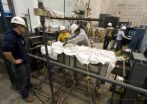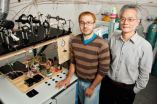(Press-News.org) WEST LAFAYETTE, Ind. - Researchers at Purdue University are studying the effects of fire on steel structures, such as buildings and bridges, using a one-of-a-kind heating system and a specialized laboratory for testing large beams and other components.
Building fires may reach temperatures of 1,000 degrees Celsius, or more than 1,800 degrees Fahrenheit, said Amit Varma, a Purdue associate professor of civil engineering who is leading the work.g1
"At that temperature, exposed steel would take about 25 minutes to lose about 60 percent of its strength and stiffness," he said. "As you keep increasing the temperature of the steel, it becomes softer and weaker."
One project focuses on how a building's steel-and-concrete floor and its connections to the building behave in a fire. Another project concentrates on how fire affects steel columns and a building's frame.
Such testing is customarily conducted inside large furnaces.
"However, in a furnace it is very difficult to heat a specimen while simultaneously applying loads onto the structure to simulate the forces exerted during a building's everyday use," Varma said.
To overcome this limitation, Purdue researchers designed a system made up of heating panels to simulate fire. The panels have electrical coils, like giant toaster ovens, and are placed close to the surface of the specimens. As the system is used to simulate fire, test structures are subjected to forces with hydraulic equipment.
In practice, beams and other steel components in buildings are covered with fireproofing materials to resist the effects of extreme heating.
"Because the steel in buildings is coated with a fireproofing material, the air might be at 1,000 degrees but the steel will be at 300 or 400 degrees," Varma said. "We conduct tests with and without fire protection."
The work is funded by the National Science Foundation and the U.S. Department of Commerce's National Institute of Standards and Technology.
The heating system is being used to test full-scale steel columns at Purdue's Robert L. and Terry L. Bowen Laboratory for Large-Scale Civil Engineering Research. It is believed to be the only such heating system in the world, Varma said.
Each panel is about 4 feet square, and the system contains 25 panels that cover 100 square feet. Having separate panels enables researchers to heat certain portions of specimens, recreating "the heating and cooling path of a fire event," Varma said.
The Bowen Lab is one of a handful of facilities where testing can be performed on full-scale structures to yield more accurate data. The 66,000-square-foot laboratory is equipped with special hydraulic testing equipment and powerful overhead cranes.
The research group also has tested 10-foot-by-10-foot "composite floor systems" - made of steel beams supporting a concrete slab - inside a furnace operated by Michigan State University. The composite design is the most common type of floor system used in steel structures.
Findings from that research will be compared with floor-system testing to be conducted at the Bowen Lab. Results from both experiments will be used to test and verify computational models used to design buildings.
"Most of these experiments are showing that we have good models, and we are using data to benchmark the models and make sure the theory and experiment agree with each other," Varma said.
Models are needed to design composite floor systems, which can be heavily damaged by fire.
"When you have a floor supporting weight, the floor starts sagging from the heat," Varma said. "It expands, but it's got nowhere to go so it starts bowing down, which produces pulling forces on the building's frame. It starts pulling on the columns and then it becomes longer and permanently deformed. After the fire, it starts cooling, and then it starts pulling on the columns even harder."
INFORMATION:
Recent research findings were detailed in a paper presented in June during the Structures in Fire conference at Michigan State University. The paper was written by graduate student Lisa Choe and Varma.
Related websites:
Amit Varma:
https://engineering.purdue.edu/CE/People/view_person?group_id=1920&resource_id=2280
Bowen Lab:
https://engineering.purdue.edu/CE/Academics/Groups/Structural/BOWEN/index_html
Structures in Fire conference: http://www.egr.msu.edu/sif10/flyer%20of%20conf/SiF10%20Conference%20Proceedings.pdf
PHOTO CAPTION:
Purdue civil engineering doctoral student Lisa Choe works with graduate student Sungwoo Oh in using a one-of-a-kind heating system to study the effects of fire on steel structures. Research assistant Michael Bratt, far left, looks on. The work is led by Amit Varma, a Purdue associate professor of civil engineering (green hardhat), seen here with graduate students Erica Fischer and Kristi Selden. (Purdue University photo/Mark Simons)
A publication-quality photo is available at http://news.uns.purdue.edu/images/2010/varma-fire.jpg
Abstract on the research in this release is available at: http://www.purdue.edu/newsroom/research/2010/101116VarmaFire.html
Engineers test effects of fire on steel structures
2010-11-17
ELSE PRESS RELEASES FROM THIS DATE:
Organ network uses Carnegie Mellon algorithm to match live kidney donors with recipients
2010-11-17
PITTSBURGH—A computer algorithm developed at Carnegie Mellon University matched living kidney donors with medically compatible transplant candidates late last month as the national Organ Procurement and Transplantation Network (OPTN), operated by the United Network for Organ Sharing (UNOS), began a national pilot program to increase the number of kidney paired-donation (KPD) transplants.
The initial run of the computer matching process included just 43 kidney transplant candidates and 45 potential living donors, but a national KPD pool eventually could include as many ...
International discussions on FRAX smooth the way for implementation in clinical practice
2010-11-17
Three days of critical international discussion and debate, led by a panel of experts from the International Society of Clinical Densitometry (ISCD) and the International Osteoporosis Foundation (IOF), have served to clarify a number of important questions pertaining to the interpretation and use of FRAX® in clinical practice.
The WHO Fracture Risk Assessment Tool (FRAX®), with models for some 26 countries, is an important new online tool that is being used by a steadily increasing number of physicians around the world. FRAX® is country-specific and calculates a patient's ...
Heart surgeries can trigger strokes, seizures and other neurological complications
2010-11-17
Strokes, seizures and other neurological complications related to heart surgery account for "considerable morbidity and mortality," Loyola University Health System neurologists report in the November issue of the journal Hospital Practice.
Other complications include delirium, central nervous system infections, pituitary gland problems, spinal cord or peripheral nerve injuries, residual effects of anesthesia and medication toxicity.
Complications can involve any part of the central and peripheral nervous systems. "Neurologic complications are always a risk with cardiac ...
Depression linked to HIV risk among South African young people, study shows
2010-11-17
University of Alberta research has discovered a strong link between depression and risky sexual behaviours such as improper condom use, transactional sex and relationship violence among young people in South Africa.
The research shows that depression is common among young South Africans, and could be making a significant contribution towards the HIV epidemic.
As well, the researchers believe that depression could be contributing to risky sexual behaviours around the world, and that preventing or treating it may reduce the global burden of sexually transmitted diseases, ...
Listening for ocean spills and their ecological effects
2010-11-17
November 16, 2010 -- Scientists who study acoustics (the "science of sound") have over the years developed a variety of techniques to probe the hidden depths of oceans. This week, many of these acoustic researchers will come together to discuss how these technologies were used to monitor April's Deepwater Horizon oil spill, to present new data on the gusher's ecological impacts, and to highlight new techniques under development that could improve our ability to detect oil in ocean water.
This special session will take place on November 17, 2010 at the 2nd Pan-American/Iberian ...
Research links damaged organs to change in biochemical wave patterns
2010-11-17
By examining the distinct wave patterns formed from complex biochemical reactions within the human body, diseased organs may be more effectively identified, says Zhengdong Cheng, associate professor in the Artie McFerrin Department of Chemical Engineering at Texas A&M University, who has developed a model that simulates how these wave patterns are generated.
His findings, which appear in the October issue of the journal "Physical Review E," detail Cheng's work with a system designed to model cells in a biochemical environment, similar to what occurs inside the human body.
His ...
Study rewrites the evolutionary history of C4 grasses
2010-11-17
CHAMPAIGN, Ill. — According to a popular hypothesis, grasses such as maize, sugar cane, millet and sorghum got their evolutionary start as a result of a steep drop in atmospheric carbon dioxide levels during the Oligocene epoch, more than 23 million years ago. A new study overturns that hypothesis, presenting the first geological evidence that the ancestors of these and other C4 grasses emerged millions of years earlier than previously established.
The findings are published in the journal Geology.
C4 plants are more efficient than C3 plants at taking up atmospheric ...
Program for young students increases interest in college attendance and medical careers
2010-11-17
Two new studies have shown that a unique program in East Harlem that helps middle school students learn practical health skills and gain a better understanding of medical conditions, such as diabetes and hypertension, resulted in increased interest in college attendance and medical careers among the students who attended the program. The results were presented at the American Public Health Association (APHA) Annual Meeting this month in Denver.
The MedStart Summer Enrichment Program was created in the summer of 2009 by Edward Chu and Melissa Schneiderman, two third-year ...
Researchers link cerebral malaria to epilepsy, behavior disorders
2010-11-17
EAST LANSING, Mich. — Almost a third of cerebral malaria survivors developed epilepsy or other behavioral disorders in the most comprehensive study to date of the disease in African children, solidifying the link between malaria and neuropsychiatric disorders that affect hundreds of thousands of children.
The research – led by Gretchen Birbeck, an associate professor of neurology and ophthalmology in Michigan State University's College of Osteopathic Medicine – appears in the current edition of The Lancet Neurology.
Cerebral malaria is a severe form of malaria affecting ...
Nanotechnology: A dead end for plant cells?
2010-11-17
Using particles that are 1/100,000 the width of a human hair to deliver drugs to cells or assist plants in fighting off pests may sound like something out of a science fiction movie, but these scenarios may be a common occurrence in the near future.
Carbon nanotubes, cylindrically shaped carbon molecules with a diameter of about 1 nanometer, have many potential applications in a variety of fields, such as biomedical engineering and medical chemistry. Proteins, nucleic acids, and drugs can be attached to these nanotubes and delivered to cells and organs. Carbon nanotubes ...


